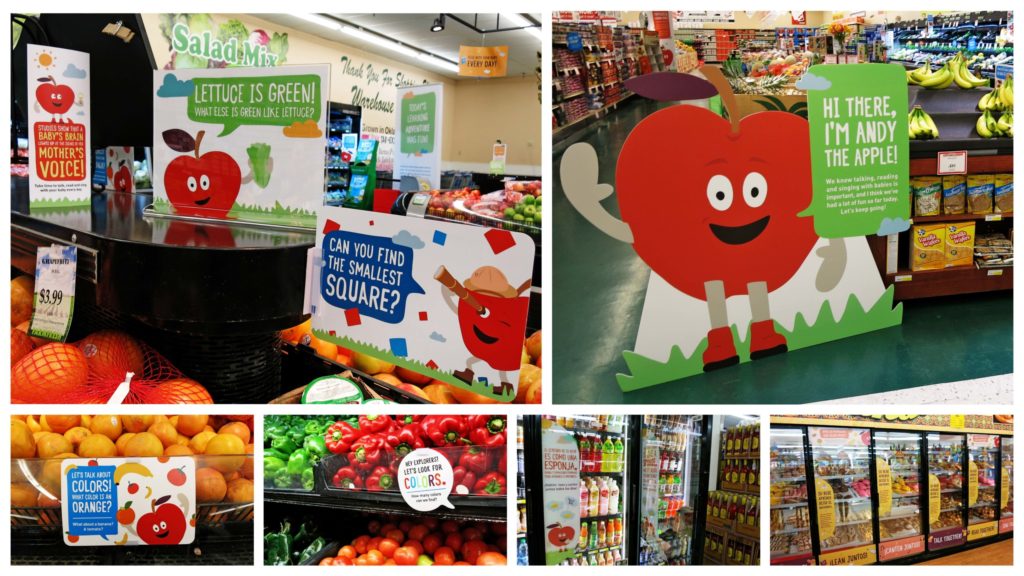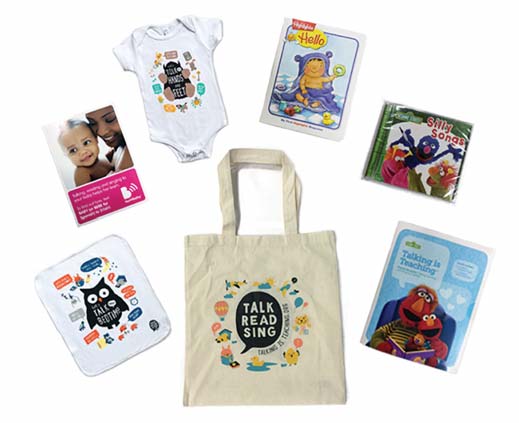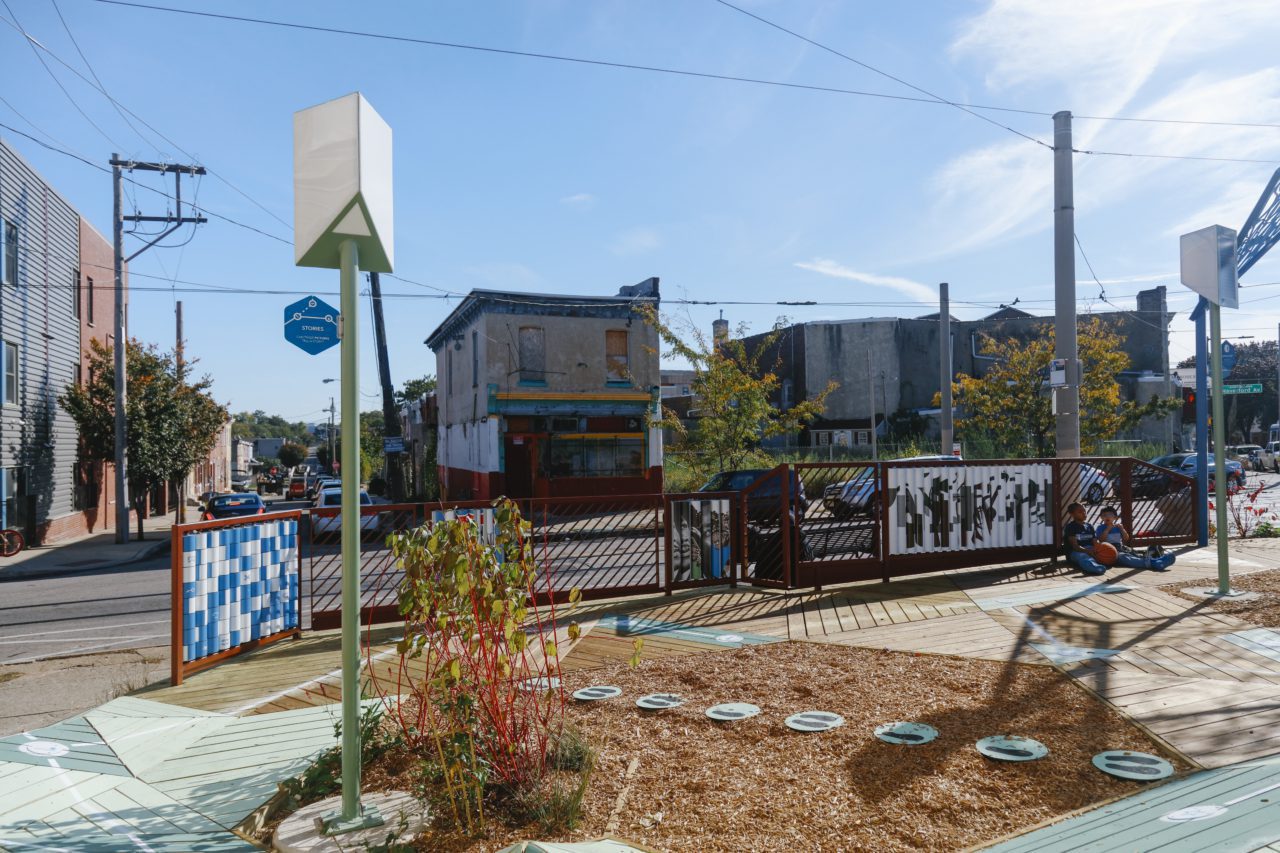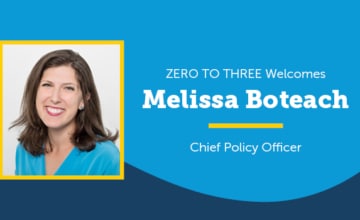Amanda Sheffield Morris and Amy Treat, Oklahoma State University
Brenna Hassinger-Das, Pace University
Martha Isabel Zapata, Oklahoma State University
Kathy Hirsh-Pasek, Temple University
Abstract
A child’s early language skills are one of the best predictors of academic success, and a number of community interventions have aimed to increase caregiver–child interactions to improve language development and related outcomes. This article describes ongoing community efforts in Tulsa, Oklahoma, and Philadelphia, Pennsylvania, aimed at enriching caregiver–child interactions during everyday moments and in community settings. These interventions target everyday spaces, such as grocery stores or bus stops, and encourage playful learning and conversations through messaging and suggested activities. Descriptions of interventions are provided, as well as initial research findings and lessons learned about program implementation and working with community partners.
Given that early language skills are one of the best predictors of academic success (Pace, Alper, Burchinal, Golinkoff, & Hirsh-Pasek, 2018), a number of community interventions have aimed to increase caregiver–child interactions to improve language development and related outcomes. These interventions target everyday spaces, such as grocery stores or bus stops, and encourage playful learning and conversations through messaging and suggested activities. Because children spend 80% of their waking time outside of school (Meltzoff, Kuhl, Movellan, & Sejnowski, 2009), everyday spaces can be opportunities for learning. However, during activities such as grocery shopping or waiting in line, caregivers are often on their phones and give children technology to keep them busy (Radesky et al., 2014). Can interventions change such behaviors and transform the places where people gather or wait into hubs for playful learning? We think so, and there is evidence to suggest this is happingin several communities across the United States.
This article describes efforts in Tulsa, Oklahoma, and Philadelphia, Pennsylvania, designed to invite high-quality caregiver–child language interactions while raising awareness of the importance of talking, reading, and singing to children from birth. Programming takes place in faith-based organizations, hospitals, grocery stores, public spaces, and through community messaging (e.g., text messages, billboards, radio announcements). In this article, we briefly describe each program and initial research findings. We end with lessons learned about implementation strategies and working jointly with community organizations.
Talk, Read, Sing Campaign in Tulsa
Talking Is Teaching: Talk, Read, Sing is a public awareness and action campaign designed to educate caregivers about the importance of talking, reading, and singing to children from birth. Using trusted messengers within the community (e.g., doctors, nurses, faith-based leaders), caregivers are encouraged to engage in language-rich activities with their children and turn everyday moments, such as bath time or grocery shopping, into teachable moments. In partnership with Too Small to Fail, The Opportunity Institute, and the George Kaiser Family Foundation (GKFF), the Talking Is Teaching campaign is being implemented in Tulsa, OK. Messages are delivered across the community, in hospitals, pediatric clinics, and other places where families with young children spend time. In addition, campaign signage is installed on city buses and billboards, and messages are shared through social media platforms and radio public service announcements.
Bright Beginnings
Bright Beginnings, an early literacy intervention, is being implemented in Tulsa hospitals by registered nurse educators as part of the Talking Is Teaching campaign and GKFF’s Birth Through Eight Strategy for Tulsa. The aim of the program is for nurses to visit all new mothers in Tulsa county before they are discharged from the hospital. During the visit, nurses deliver a Talking Is Teaching toolkit and briefly educate caregivers about the important role they play in children’s early brain and language development. The literacy materials in the toolkit are used to help caregivers understand the importance of talking, reading, and singing to children from birth. Materials are available in Spanish and English, and nurse educators deliver the program in either language.
To gauge the effectiveness of the Bright Beginnings intervention, researchers from Oklahoma State University examined caregivers’ awareness of the importance of talking, reading, and singing to young children. Quantitative (i.e., surveys) and qualitative (i.e., interviews) methods were used, and data were collected in partnership with The Parent–Child Center of Tulsa and the text4baby health messaging service app. Surveys and interviews (N = 572) were conducted in both English and Spanish. Surveys were sent to text4baby enrollees in Tulsa County and surrounding areas (n = 357) regarding their attitudes and behaviors toward talking, reading, and singing to babies, and interviews were conducted with caregivers in the hospital and over the phone (n = 215 with pre-post surveys).
Survey results indicated that, overall, participants endorsed the importance of talking, reading, and singing to babies. However, parents in Tulsa who received the toolkits (n = 62), compared to those who did not (n = 75), endorsed a greater importance of talking, reading, and singing to babies. Parents who received the toolkits also reported talking more to babies during everyday moments such as diaper changing, repeating sounds back to their baby, and reading and singing more often. In addition, after receiving the toolkits in the hospital, mothers reported greater awareness of the Talking Is Teaching messaging found in the community on billboards, in radio public service announcements, and in doctors’ offices, suggesting that the toolkit and the Bright Beginnings visit primed caregivers to receive the Talking Is Teaching messaging. Mothers who received the Bright Beginnings visit in the hospital also reported remembering the overall message of the importance of talking, reading, and singing to babies and were pleased with the general experience. Preliminary findings indicated that men, younger caregivers, Spanish-speaking caregivers, and individuals with lower levels of education have less initial positive attitudes toward talking, reading, and singing to babies, so these are potential leverage points for intervention (Singh, Zapata, Treat, Jespersen, & Morris, 2018).
To learn more about mothers’ experiences with the hospital visit and their use of the toolkit, face-to-face qualitative interviews (n = 19, 12 English, 7 Spanish) were conducted and analyzed to ensure saturation and validity of themes (Creswell, 2007). Overall, mothers reported using and enjoying the items in the toolkit. Toolkit items made a difference in their families, as they reported talking and reading to their babies more as a result of the toolkit and messaging.
After talking about it with her [the nurse educator], I wasn’t embarrassed or anything to talk to my baby; I knew he may not understand me, but I’m sitting in a public space and talking to my baby. It made me feel like it was very useful, and it was a helpful thing to know. —Bright Beginnings participant
Well, whenever I got the bag and there was a book in it, I was surprised that you can read to them (babies). That you’re supposed to be doing that. I wouldn’t have known to do that. —Bright Beginnings participant
Faith-Based Literacy Events
The Faith-Based Literacy Initiative is being implemented by Tulsa Educare Beyond the Walls. Educare is a high-quality early learning program targeting low-income families with young children. Tulsa’s Educare Beyond the Walls is a program designed to reach families in the community who have young children that do not attend an Educare school. The Faith-Based Literacy Initiative targets faith leaders and community faith-based organizations to deliver the Talking Is Teaching messages to families during Family Engagement nights at local faith-based organizations. The goal of the events is to show caregivers the power they have to turn everyday activities such as reading with their children into learning opportunities. Educare staff provide training to faith leaders and volunteers who then organize and staff the events and deliver the curriculum to families.. A monthly curriculum and children’s books are provided for families at each event. During events, families have dinner, participate in early literacy activities with their children, and learn interactive reading strategies to support learning. The program serves caregivers and children up to 5 years old. As of February 2019, the program had engaged a total of 32 faith-based partners who have hosted 562 literacy events.
To evaluate the faith-based events, Educare Beyond the Walls obtained permission from 12 faith-based organizations hosting the program to collect survey data from event attendees. The research team from Oklahoma State University visited one literacy event at each of the 12 faith-based organizations where events were ongoing and surveyed caregivers on their behaviors and beliefs before and after programming on the same survey (i.e., a retrospective pre-post test design). One caregiver per family group completed the survey (N = 173). Overall, caregivers were extremely satisfied with the literacy events. Caregivers who attended the events reported talking, reading, and singing more frequently, and using “dialogic reading strategies” (e.g., more conversational strategies when reading with their children) after participating in the program. They also reported an increased desire to read with their child as a result of the literacy events. Qualitative study results with caregivers (n = 13) and faith leaders (n = 11) were similar (Jespersen, Zapata, Singh, & Morris, 2018).
I’ll say that my son, he wasn’t really a big book person, and he’s only 2; so I didn’t really expect him to be really into it, but he carries his books around and says, “My book, my book.” And he’s so happy about he’s got a book. And he’s twirling around in a circle saying “his book,” so I’m excited that he likes to read now. —Family participant
I don’t think my group was that aware of the younger the better, starting in the womb. Maybe they had heard it, but I don’t think they understood the importance of it until we started talking about it and putting it into practice. It has definitely been an eye-opener. —Faith-based leader

The goal of Urban Thinkscape is to incorporate playful learning elements into architecture and public spaces to promote curiosity and a desire to learn while also encouraging family engagement. Photo by Sahar Coston-Hardy Photography
Playful Learning Landscapes in Philadelphia
The Playful Learning Landscapes initiative creates play experiences for children and families in public spaces, which are designed to foster caregiver–child interactions and playful learning, based on research in the science of learning (Hassinger-Das, Bustamante, Hirsh-Pasek, Golinkoff, Magsamen et al., 2018).
Urban Thinkscape
In the Urban Thinkscape project (Hassinger-Das, Busta-mante, Hirsh-Pasek, & Golinkoff, 2018) researchers asked whether it might be possible to reimagine a bus stop in an under-resourced community as a learning opportunity. Urban Thinkscape marries the Conscious Cities movement in design with research from the science of learning. Researchers involved in Conscious Cities are investigating the ways in which learning and development are influenced by the built environment (Brekke, 2016). The goal of Urban Thinkscape is to incorporate playful learning elements into architecture and public spaces to promote curiosity and a desire to learn while also encouraging family engagement.
The project was built with feedback and collaboration from members of the local community—who tailored it to their own specific needs and desires. Neighbors suggested the location of the installation and gave feedback on design concepts. Designs installed included the following:
- Puzzle Bench (e.g., three puzzle walls were used to encourage spatial skills; Verdine, Golinkoff, Hirsh-Pasek, & Newcombe, 2017)
- Jumping Feet (e.g., families were encouraged to use a hopscotch board designed to promote attention, memory, impulse control, and flexibility. Families were encouraged to try to jump with one foot where they saw a two-foot pattern and two feet where they saw a one-foot pattern.)
- Stories (e.g., icons were placed on mini mounds constructed on the ground to encourage narrative skills)
- Hidden Figures (e.g., finding hidden shapes in a high structure that projected shapes onto the ground)
Community members, trained to assess behaviors, collected observational data for caregiver–child groups at Urban Thinkscape (n = 165) site and a control site playground (n = 115) in the same neighborhood. They coded for child and caregiver behaviors related to conversational content (i.e., spatial language, numerical language), verbal interactions (i.e., asks questions, provides description), and nonverbal engagement features (i.e., laughs, points). These specific language types—spatial and numerical—have been shown to relate to child outcomes (Levine, Suriyakham, Rowe, Huttenlocher, & Gunderson, 2010).
Results demonstrated that caregiver–child groups at Urban Thinkscape interacted more and had more conversations there than they did before the installation of the designs. The positive effects of Urban Thinkscape highlight the possibility of using the city itself as an agent of change to improve outcomes for children and families.

Supermarket Speak is an effort to transform the routine activity of grocery shopping into a fun and educational experience for families. Photo by Saxum
Supermarket Speak in Philadelphia
In an effort to transform the routine activity of grocery shopping into a fun and educational experience for families, Ridge, Weisberg, Ilgaz, Hirsh-Pasek, and Golinkoff (2015) developed the Supermarket Speak program. They installed colorful signs in three different grocery stores serving both low- and middle-income populations in the Philadelphia region. At the entrance of the store, the researchers placed a sign stating: “Talking to your child helps their language grow!” They also included two signs on the doors of coolers in the frozen vegetable and dairy sections. In each store, there were five signs total (including the entrance sign). In the dairy section, signs featured a cartoon cow and a gallon of milk and stated: “Question for your child: Where does milk come from?” or “Why is milk good to drink?” In the frozen vegetable section, signs featured cartoon vegetables and stated: “Question for your child: What’s your favorite vegetable?” or “Why are vegetables good to eat?”
Unobtrusive observers recorded instances of caregiver–child conversations and interactions, including question-asking and answering behaviors and conversational turns, between caregivers and their children approximately 2.5–8 years old when the signs were posted (n = 37) or not posted (n = 34). Analyses revealed that, when the signs were up, the amount and quality of caregiver–child interaction increased for families in the supermarket in the low-income area by 33%. The presence of the signs did not make a significant difference
in caregiver–child conversations and interactions occurring in a supermarket located in a middle-income neighborhood. These results suggested that this low-cost, simple intervention fosters the type of caregiver–child conversations and interactions that have the potential to impact later language, literacy, and mathematics outcomes for children from disadvantaged backgrounds.
Supermarket Speak With STEM
To extend the work of Ridge and colleagues (2015), Hanner, Braham, Elliott, and Libertus (2019) created Supermarket Speak With STEM to examine the effects of placing signs with math-related conversational prompts in grocery stores to encourage caregivers to engage math-related talk with their preschool children. Unobtrusive observers who did not know the study hypotheses recorded interactions between caregivers (n = 179) and children (2–5-year-olds) in three different conditions (math, general language, baseline) in three different store areas: milk, bread, and eggs. The signs featured cartoon characters with text that encouraged caregivers to ask children questions (e.g., math condition: “How many glasses of milk do you drink in a day? How many do you drink in a week?”; general language condition: “Where does milk come from? Why is milk good to drink?”). In the baseline condition, there were no signs present. Results demonstrated that 53% of the caregivers in the math condition engaged in math-related conversations compared to 23% of caregivers in the general language condition and 23% in the baseline condition. This study demonstrated the ability of a simple signage intervention to increase caregivers’ use of math talk with their children.
Supermarket Talking Is Teaching in Tulsa
Based on the work of Ridge and colleagues (2015) in Philadelphia, researchers developed and installed Talking Is Teaching signage in two local grocery store chains. In Tulsa, Saxum Public Relations and the GKFF assisted with the creation of the signs. Signage encouraged families to embark on an adventure with “Andy the Apple.” Signs prompted caregivers to engage in conversations throughout the store and were centered around early literacy and math. Researchers installed signs in four grocery stores visited primarily by low- and mixed-income families, two of which were primarily patronized by Hispanic Spanish-speaking families, where the signs were in Spanish.
Using similar procedures as Supermarket Speak, observers assessed caregiver–child interactions before (n = 282, signs down) and after (n = 338, signs up) the signs were installed. Overall, in Tulsa stores, families showed moderate levels of caregiver–child interaction, similar to the middle-income sample in Philadelphia. Comparisons of data from the signs-down and the signs-up condition indicated that the signage did not elicit increased levels of caregiver–child interaction, possibly because the sample was more middle-income, or possibly because of poor sign placement. Researchers interviewed families (n = 102) as they left the stores where signs had been installed. During these exit interviews, caregivers were asked about their experience with the signs while shopping, and many caregivers (44%) reported they did not see the signage at the stores. Moreover, researchers noted some signs were removed or covered by sale signage placed by store employees. These factors help explain the lack of findings in the signs-up versus signs-down condition in Tulsa. In addition, signs-down observations were collected mostly in the summer, while signs-up were collected during the school year when there may have been less time available for grocery shopping.
Some interesting findings did emerge from data collection, however. Results from the exit interviews indicated that, compared to Hispanic families, non-Hispanic families found the signs useful and used the prompts on the signage to engage with their children more often. In addition, we did find that, overall, the Spanish-speaking families talked more regardless of signage. These findings illustrated potential cultural differences that should be considered in future work.

The literacy materials in the Bright Beginnings Talk Read Sing Toolkit are used to help caregivers understand the importance of talking, reading, and singing to children from birth. Photo provided by the George Kaiser Family Foundation.
Lessons Learned and Next Steps
Initial evidence suggested that initiatives such as Playful Learning Landscapes and Supermarket Speak have the ability to transform everyday spaces and locations into opportunities for increased caregiver–child conversation and interaction—and also playful learning. Playful Learning Landscapes encourage families to see themselves as active participants in the quest to make community and public spaces more relevant for learning and engagement. Community campaigns such as Talking Is Teaching prime caregivers to receive messaging about reading and talking. Moreover, in-person experiences with trusted messengers in the community impact attitudes and behaviors about talking, reading, and singing. Programs may find greater impacts in the future by targeting specific groups such as Spanish-speaking caregivers, caregivers from lower socioeconomic groups, and fathers in particular. From this work, we have also learned that it is important to have clear communication with community partners. For example, for programs such as Supermarket Speak, it is important to have buy-in from all employees in the store so that they can facilitate and support programming by not moving or covering signs.
In summary, frequent caregiver–child interactions, or conversational turns, promote cognitive, language, and social–emotional development (Adamson, Bakeman, Deckner, & Nelson, 2014). The projects described in this article, taken together, demonstrated that it is possible to do interventions in communities to encourage caregiver–child interactions in precisely the ways that build foundations for learning. It is critical, however, to ensure that community members are involved at all stages, that families feel empowered, and that everything added is done in culturally sensitive ways.
Acknowledgments
Urban Thinkscape was supported by funding from the William Penn Foundation, grant number 103-15. Funding for the Tulsa programs was from the George Kaiser Family Foundation, Too Small to Fail, and the Opportunity Institute. The authors would like to thank community leaders and members who made our work possible, particularly Ms. Bettye Ferguson, president of the Belmont Alliance Civic Association, and the Parent Child Center of Tulsa.
Authors
Amanda Sheffield Morris, PhD, is a Regents Professor and George Kaiser Family Foundation Chair in Child Development in the Department of Human Development and Family Science at Oklahoma State University. She is a developmental scientist who studies parenting and the development of children’s emotion regulation. Her work focuses on children from disadvantaged backgrounds and parenting interventions aimed at increasing successful development through nurturance and guidance. She has published numerous articles and co-edited multiple books on parenting and child development.
Amy Treat, PhD, is a recent graduate of Oklahoma State University with a doctorate in human development and family science. Her research examines how adverse childhood experiences impact parenting attitudes and behaviors and how that influences children’s cognitive, language, and social and emotional development.
Brenna Hassinger-Das, PhD, is an assistant professor of psychology at Pace University. Her research examines young children’s play and learning in home, school, and community contexts, particularly for children experiencing poverty. Her areas of expertise encompass executive functioning, early number sense, and vocabulary acquisition. She is committed to translating her research for use by the public through community-based research projects involving caregivers and young children.
Martha Isabel Zapata, PhD, is a research scientist in human development and family science at Oklahoma State University. Since 2015, she has been involved in the evaluation of programmatic initiatives in Tulsa, OK, aimed at fostering positive parenting, child development, and early literacy. Dr. Zapata’s qualitative and quantitative academic research has generated numerous peer-reviewed publications, most of which have focused on the topics of youth development and mental health in Latino families.
Kathy Hirsh-Pasek, PhD, is the Stanley and Debra Lefkowitz Faculty Fellow in the Department of Psychology at Temple University and a senior fellow at the Brookings Institution. Her research examines the development of early language and literacy as well as the role of play in learning. With her longterm collaborator, Roberta Golinkoff, she is author of 14 books and hundreds of publications and is a recipient of many of the major awards in the area of child psychology and education.
Suggested Citation
Sheffield Morris, A., Treat., A., Hassinger-Das, B., Zapata, M. I., & Hirsh-Pasek, K. (2019). Opportunities to enrich caregiver–child interactions: Community efforts in Oklahoma and Pennsylvania. ZERO TO THREE Journal, 40(2), 52–58.
References
Adamson, L. B., Bakeman, R., Deckner, D. F., & Nelson, P. B. (2014). From interactions to conversations: The development of joint engagement during early childhood. Child Development, 85, 941–955.
Brekke, H. (2016). How does the built environment affect behaviour and cognition? In A. Fritz, (Ed.), Conscious cities: An anthology No. 1. London, UK: The Cube and the Museum of Architecture.
Creswell, J. W. (2007). Qualitative inquiry and research design: Choosing among five approaches. Thousand Oaks, CA: SAGE Publications.
Hanner, E., Braham, E. J., Elliott, L., & Libertus, M. E. (2019). Promoting math talk in adult–child interactions through grocery store signs. Mind, Brain, and Education, 13(2), 110–118.
Hassinger-Das, B., Bustamante, A. S., Hirsh-Pasek, K., Golinkoff, R. M., Magsamen, S., Robinson, J. P., & Winthrop, R. (2018). Learning Landscapes: Can urban planning and the learning sciences work together to help children? Global Economy and Development Working Paper 124. Washington DC: The Brookings Institution.
Hassinger-Das, B., Bustamante, A. S., Hirsh-Pasek, K., & Golinkoff, R. M. (2018). Learning landscapes: Playing the way to learning and engagement in public spaces. Education Sciences, 8(2), 74.
Jespersen, J. E., Zapata, M., Singh, R., & Morris, A. S. (2018, May). Utilizing faith-based literacy events to build community and promote positive parenting. Poster presented at the 16th World Congress of the World Association for Infant Mental Health, Rome, Italy.
Levine, S. C., Suriyakham, L. W., Rowe, M. L., Huttenlocher, J., & Gunderson, E. A. (2010). What counts in the development of young children’s number knowledge? Developmental Psychology, 46, 1309–1319.
Meltzoff, A. N. Kuhl, P. K. Movellan, J., & Sejnowski, T. J. (2009). Foundations for a new science of learning. Science, 325, 284–288, doi:10.1126/science.1175626
Pace, A., Alper, R., Burchinal, M., Golinkoff, R. M., & Hirsh-Pasek, K. (2018). Measuring success: Within- and cross-domain predictors of academic and social trajectories in elementary school. Early Childhood Research Quarterly, 46, 112–125. https://doi.org/10.1016/j.ecresq.2018.04.001
Radesky, J. S., Kistin, C. J., Zuckerman, B., Nitzberg, K., Gross, J., Kaplan-Sanoff, M., … Silverstein, M. (2014). Patterns of mobile device use by caregivers and children during meals in fast food restaurants. Pediatrics, 133(4), e843–e849.
Ridge, K. E., Weisberg, D. S., Ilgaz, H., Hirsh-Pasek, K. A., & Golinkoff, R. M. (2015). Supermarket Speak: Increasing talk among low-socioeconomic status families. Mind, Brain, and Education, 9(3), 127–135.
Singh, R., Zapata, M., Treat, A., Jespersen, J., & Morris, A. S. (2018, May). Talk, read, and sing campaign: Attitudes and behavior towards talking, reading, and singing to babies. Poster presented at the 16th World Congress of the World Association for Infant Mental Health, Rome, Italy.
Verdine, B. N., Golinkoff, R. M., Hirsh-Pasek, K., & Newcombe, N. S. (2017). Links between spatial and mathematical skills across the preschool years. Monographs of the Society for Research in Child Development, 82(1), 1–150.




